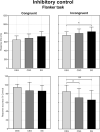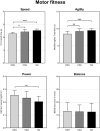Differences in inhibitory control and motor fitness in children practicing open and closed skill sports
- PMID: 33597630
- PMCID: PMC7889632
- DOI: 10.1038/s41598-021-82698-z
Differences in inhibitory control and motor fitness in children practicing open and closed skill sports
Abstract
The aim of the present study was to investigate the differences between types of sport (i.e., closed vs. open skills sport) on inhibitory control and motor fitness in children. Forty-nine children were allocated into three groups based on their sports participation, which comprised an open skill sport group, a closed skill sport group, and a sedentary group. Participants were tested on cognitive performance (inhibitory control by the Flanker task) and motor fitness (reaction time, speed, agility, power, balance). Open skill sport group appeared to display higher inhibitory control (response time and accuracy of incongruent condition of the Flanker task) and motor fitness performance (reaction time, speed, agility, power) than sedentary group, whereas its superiority over closed skill sport group was found only in speed and agility. Moreover, closed skill sport group had only a better reaction time than sedentary group. Our data supports the framework according to which cognitive demands in complex motor actions may contribute to explain the beneficial effects of exercise on inhibitory control. This might suggest that the complexity of the environment (typical in open skill sports) in which sport training is performed plays a key role for both cognitive and motor development in children.
Conflict of interest statement
The authors declare no competing interests.
Figures



References
MeSH terms
LinkOut - more resources
Full Text Sources
Other Literature Sources
Medical

